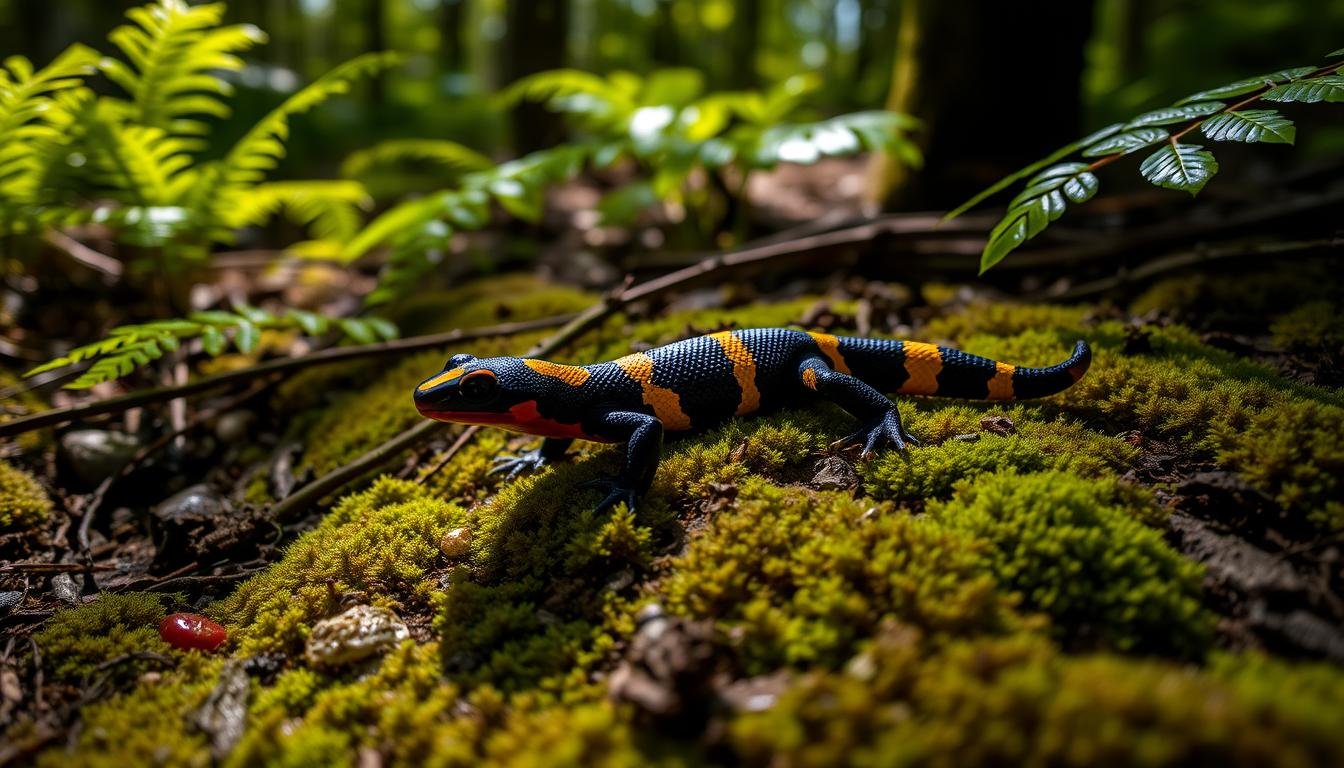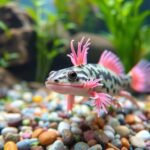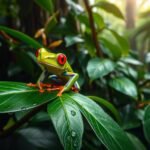Fire salamanders (Salamandra salamandra) are found in mainland Europe, Mediterranean islands, northern Africa, and the Near East. This guide will help you set up a great home for them. It covers terrarium setup, temperature, humidity, and what to feed them. With the right care, they can live up to 30 years.
Creating the right habitat is key for fire salamanders’ health. They need specific conditions for temperature, moisture, and substrate. By understanding their needs, you can make a naturalistic home for them to thrive.
Understanding Fire Salamanders (Salamandra salamandra)
The fire salamander is a fascinating amphibian known for its striking looks. These large, ground-dwelling salamanders can reach up to 12 inches long. They have a glossy black body with bright yellow spots or patterns.
The different fire salamander subspecies, like Salamandra salamandra terrestris and Salamandra salamandra gallaica, show unique color and pattern variations.
Physical Characteristics and Size
Adult fire salamanders are 5 to 12 inches long. Females are usually bigger than males. They have strong bodies, broad heads, and short limbs.
Their bright colors help them blend in and warn off predators about their toxic skin.
Natural Distribution Range
The fire salamander lives in Central and Southern Europe, West Asia, and North Africa. They like damp, cool places in deciduous and mixed forests.
Species and Subspecies Overview
There are 12 to 17 subspecies of fire salamanders, with most variation in the Iberian Peninsula. Well-known subspecies include Salamandra salamandra terrestris, Salamandra salamandra gallaica, and Salamandra salamandra almanzoris.
Each subspecies has its own unique features and adaptations to their local environments.
| Subspecies | Distinguishing Features | Distribution |
|---|---|---|
| Salamandra salamandra terrestris | Bright yellow spots on a black body | Central Europe |
| Salamandra salamandra gallaica | Smaller size, variable coloration | Iberian Peninsula |
| Salamandra salamandra almanzoris | Elongated body, distinct stripes | Spain |
Natural Habitat and Behavior Patterns
Fire salamanders are mostly nocturnal and terrestrial as adults. They like cool, damp environments. They hide in leaf litter, under logs, or in underground burrows. They are rarely seen in open areas and only go to water to breed.
Their natural home is forest floors with lots of hiding spots and moisture-retaining substrates.
The Fire Salamander lives in central and southern Europe, northern Africa, and the Middle East. They like woodlands with shade, ponds, or streams for breeding. They weigh about 19.1 grams and are 15 to 30 cm long. They can live over 14 years, with an average of 24 years in captivity.
Fire Salamanders are toxic and have bright colors to defend themselves. They eat invertebrate prey like earthworms, slugs, and beetles. They are popular pets and used in research, but laws have cut down on their capture.
It’s key to protect their natural habitats to save Fire Salamanders. They face threats from pollutants and habitat loss. Being on the IUCN Red List, they are at risk from a fungus. Their genetic diversity varies by region, affected by physical barriers.
Fire Salamander Habitat Requirements
Temperature and Climate Control
Keeping the right temperature and climate is key for fire salamanders. They do best in temperatures between 60°F (15°C) and 68°F (20°C). The temperature should drop a bit at night.
It’s important to keep them away from temperatures over 75°F (24°C). They are very sensitive to heat and can get stressed in warm conditions.
Humidity and Moisture Levels
Fire salamanders need a bit more humidity than regular room air. Their substrate should be damp but not too wet. This keeps their skin and breathing system healthy.
Coco husk, sandy topsoil, or moss are great substrates. They let the salamanders burrow and keep the right humidity.
Substrate Requirements
The substrate is very important for fire salamanders. Good substrates are coco husk, sandy topsoil, or moss. They offer a natural place for the salamanders to hide and burrow.
These substrates should be kept damp but not too wet. This meets the humidity needs of the salamanders.
| Environmental Factor | Optimal Range |
|---|---|
| Temperature | 60°F (15°C) to 68°F (20°C) |
| Humidity | Slightly above room level, consistently damp substrate |
| Substrate | Coco husk, sandy topsoil, or moss |
Terrarium Setup and Size Guidelines

A glass terrarium is the best choice for your fire salamanders. It lets heat pass through easily, helping them stay healthy. For adults, a terrarium of 450 x 450 x 300 mm (17 x 17 x 12 inches) is a good start. Bigger ones are even better.
A 15-20 gallon tank is perfect for 2 adult fire salamanders. It gives them enough space to roam and find their favorite spots.
Your terrarium should look like a natural woodland. It should have both land and water areas. This is crucial if you want to breed them, as they need the right environment to reproduce.
| Habitat Feature | Requirement |
|---|---|
| Terrarium Size | Minimum 450 x 450 x 300 mm (17 x 17 x 12 inches) for adults, 15-20 gallon tank recommended |
| Terrestrial Area | Moist, well-draining substrate like sphagnum moss, leaf litter, or coconut fiber |
| Aquatic Area | Small pond or water dish with dechlorinated water, maintained at a depth of 2-4 inches |
| Hiding Spots | Rocks, logs, and live plants to provide ample cover and shelter |
| Lighting | Low-watt incandescent bulb for 10-12 hours of light daily |
| Temperature | 60-68°F (15-20°C), with a slight nighttime drop of 5°C |
| Humidity | Maintain around 70%, misting the enclosure regularly |
By following these guidelines, you can make a great home for your fire salamanders.
Creating the Perfect Microhabitat
Building a good home for fire salamanders is key to their happiness and health. They need the right mix of conditions to do well. The right hiding spots, water, and plants make a great place for them to live.
Hiding Spots and Shelter
Fire salamanders are most active at night and hide during the day. Use things like bark tunnels, cork bark, and terracotta pots for them to hide. Place these spots in both wet and dry parts of their terrarium.
Water Features and Drainage
They need a shallow water bowl to stay moist. Change the water every day to keep it clean. Good drainage helps keep the humidity right and stops water from getting too still.
Plant Selection and Decoration
Adding live plants makes the terrarium look nice and natural. But, pick plants that are safe for them. Ferns and mosses are good because they’re low-growing and keep the air moist. Make sure the plants and decorations let the salamanders move around easily.
With careful planning, you can make a great home for your fire salamanders. Focus on hiding spots, water, and the right plants. This way, they can live happily in their new home.
Environmental Maintenance Requirements
Keeping the right environment is key for fire salamanders in captivity. Regular terrarium cleaning and checking water quality and temperature are musts. These steps help your salamanders stay healthy and happy.
Start with daily water changes to keep the habitat clean. Also, clean up any waste or uneaten food right away to stop contamination. Every now and then, do a deep clean of the whole enclosure. Replace the substrate and disinfect the surfaces.
It’s also important to keep an eye on the temperature. Fire salamanders like cooler places, best between 60-70°F (15-21°C). Use the right heating tools and check the temperature often to keep it safe.
Don’t forget to keep the humidity right. Mist the enclosure often to keep humidity at 80-100%. But, be careful not to make the substrate too wet, as it can cause bacteria and other problems. By following these steps, you can make a great home for your fire salamanders.
Dietary Needs in Captivity
Fire salamanders are meat-eaters and need a diet full of live insects. Good food choices are crickets, worms, slugs, and small bugs. It’s key to feed them a mix of foods to keep them healthy.
Live Food Options
- Crickets
- Nightcrawlers
- Mealworms
- Tubifex worms
- White worms
- Bloodworms
- Brine shrimp
Most fire salamanders in the U.S. come from Europe. They arrive in spring, often with pregnant females. Wild ones can cost $50 or more each.
Feeding Schedule and Portions
Adult fire salamanders need food 2-3 times a week. Young ones should eat every 1-2 days. Feed them at night when they’re most active.
| Salamander Age | Feeding Frequency |
|---|---|
| Adults | 2-3 times per week |
| Juveniles | Every 1-2 days |
Fire salamanders can grow up to 12 inches long and live 10 years in captivity. A varied fire salamander diet keeps them healthy and long-lived.
Health Considerations in Captive Environments

Caring for fire salamanders in captivity needs special care. These amphibians have glands that release toxins. These toxins can irritate human skin if not handled right.
It’s important to be careful when working with fire salamanders. Always wear gloves or use tongs to handle them. Avoid touching their secretions directly. Wash your hands well after touching them to stop toxin transfer.
Watch the fire salamanders for signs of stress or illness. Look for loss of appetite, odd behavior, or skin changes. Keep their environment clean and controlled to avoid sickness. The right temperature, humidity, substrate, and hiding spots are key for their health.
| Health Concern | Potential Causes | Preventative Measures |
|---|---|---|
| Skin irritation | Exposure to toxins from parotoid glands | Wear gloves or use tongs when handling, wash hands thoroughly after contact |
| Bacterial infections | Unclean environment, poor water quality | Maintain a clean and well-regulated habitat, perform regular water changes |
| Stress-related behavior | Inadequate hiding spots, improper temperature or humidity | Provide ample hiding places and maintain ideal environmental conditions |
Understanding fire salamander health and taking the right handling precautions is crucial. This way, you can keep these amazing creatures safe in captivity. It also helps avoid problems caused by toxin secretion.
Breeding Environment Requirements
To breed fire salamanders in captivity, you need to mimic their natural seasons. Start with a cooler period and then switch to a warmer, wetter cycle. Make sure there’s a water area for the larvae, with good filtration and water quality.
Seasonal Changes and Cycling
Fire salamanders need specific environmental signals to breed. To mimic this, adjust the temperature and humidity levels:
- Begin with a cooler period of 55-60°F (13-16°C) for several months, mimicking winter.
- Then, raise the temperature to 60-68°F (16-20°C) and increase humidity to start the breeding season.
- Keep these warmer, wetter conditions for weeks to support mating and larval development.
Breeding Setup Specifications
Create a water feature in the enclosure for the salamanders to lay their larvae. The water must be filtered and of optimal quality for the larvae:
- Ensure the water depth is at least 6 inches (15 cm) for the larvae.
- Install adequate water flow and filtration to keep the water clean and oxygen-rich.
- Keep an eye on and adjust water parameters like temperature, pH, and oxygen levels.
By closely mimicking their natural breeding conditions, you can boost the chances of successful fire salamander reproduction in captivity.
Common Habitat-Related Issues
Keeping the right habitat for fire salamanders is key to their health. But, several common problems can harm them if not fixed fast. High temperatures over 75°F (24°C) can cause dehydration and other issues.
Another big problem is skin issues from wrong humidity or substrate. Fire salamanders need the right moisture to keep their skin healthy. Without enough humidity, their skin can dry out, get irritated, or even get infected. Also, the wrong substrate can make it hard for them to absorb moisture, leading to skin problems.
Not having enough hiding spots can also stress out fire salamanders. These night creatures need lots of places to hide to feel safe and act naturally. Without enough hiding spots, they might get anxious, stop eating, and even get sick.
- Watch for signs of dehydration, such as lethargy, loss of appetite, or unusual behavior.
- Promptly address any issues by adjusting the temperature, humidity, or substrate to meet the salamanders’ needs.
- Ensure that the habitat provides plenty of hiding spots and refuges for the salamanders to feel safe and secure.
By staying alert and fixing any habitat problems quickly, you can keep your fire salamanders healthy and happy.
| Habitat Requirement | Ideal Range | Potential Issues |
|---|---|---|
| Temperature | 60-75°F (15-24°C) | Temperature stress above 75°F (24°C) |
| Humidity | 80-100% | Skin problems due to inadequate humidity |
| Substrate | Moist, well-drained soil or moss | Skin irritation from unsuitable substrate |
| Hiding Spots | Ample cover and refuges | Stress from lack of hiding places |
Advanced Habitat Enrichment Techniques
Creating a stimulating environment is key for fire salamanders in captivity. A bioactive setup, like a forest floor, is a great idea. It includes live plants, beneficial insects, and natural substrates. This setup is dynamic and self-sustaining, just like their natural home.
To make the terrarium more interesting, add varied textures and levels. Think about using large rocks, driftwood, and small platforms. These features offer hiding spots and places to explore, making the terrarium visually appealing.
Keeping the terrarium’s humidity and moisture right is crucial. Misting systems or foggers can help, mimicking rain. Also, changing the lighting and temperature with the seasons helps. This way, the terrarium feels more like their natural habitat.
| Bioactive Setup Components | Benefits |
|---|---|
| Live Plants | Provide natural cover, humidity regulation, and a more naturalistic appearance |
| Beneficial Insects | Assist in nutrient cycling and contribute to a self-sustaining ecosystem |
| Natural Substrates | Mimic the forest floor, allowing for burrowing and natural behaviors |
| Varied Textures and Levels | Offer exploration opportunities and hiding spots for the salamanders |
| Misting Systems or Foggers | Maintain optimal humidity and create a more dynamic environment |
| Seasonal Lighting and Temperature Adjustments | Simulate natural cycles, promoting natural behaviors and health |
Using these advanced techniques, you can make a terrarium that feels like their natural home. This promotes their health and natural behaviors.
Conclusion
Creating the right habitat is key for fire salamanders’ health and happiness in captivity. By mimicking their natural home, keepers can help these amphibians live up to 30 years. It’s important to keep the right temperature, humidity, and substrate, and to feed them a varied diet.
It’s also crucial to watch the habitat closely and make changes as needed. This helps prevent health problems and keeps the enclosure natural and thriving. With careful management and knowledge of their needs, both hobbyists and professionals can give fire salamanders the best life in captivity.
By creating a natural habitat and keeping the environment right, keepers can help fire salamanders live long, healthy lives. Understanding their habitat needs is the first step to successful care and conservation of these unique amphibians.
FAQ
What are the physical characteristics and size of fire salamanders?
Fire salamanders are large, growing 5-12 inches long. They have a glossy black body with bright yellow blotches. The pattern varies between subspecies.
Where are fire salamanders naturally found?
They are found in Central and Southern Europe, West Asia, and Northern Africa. They live in deciduous and mixed forests.
What are the different subspecies of fire salamanders?
There are several subspecies, including S. s. salamandra, S. s. terrestris, and S. s. gallaica.
What are the natural habitat and behavior patterns of fire salamanders?
As adults, they are mostly nocturnal and live on land. They like cool, damp places. They hide in leaf litter, under logs, or in burrows.
They are rarely seen in open areas. They return to water only for breeding.
What are the temperature and humidity requirements for fire salamanders in captivity?
They need temperatures between 60-68°F (15-20°C), with a slight drop at night. They are sensitive to heat. Temperatures above 75°F (24°C) cause stress.
Humidity should be slightly above room level. The substrate should be damp but not waterlogged.
What type of terrarium setup is suitable for fire salamanders?
A glass terrarium is best, as it allows heat to escape. Adults need a terrarium of at least 450x450x300mm. Larger enclosures are better.
The setup should look like a woodland, with both terrestrial and aquatic areas.
What are the essential habitat features and decorations for fire salamanders?
They need hiding spots like bark tunnels, plant pots, or cork bark. A shallow water dish for soaking is essential, changed daily.
Live plants can add a natural look. But make sure they’re safe for amphibians.
How should the fire salamander’s habitat be maintained?
Regular maintenance is key. Daily water changes and spot cleaning of waste are important. Periodic deep cleans of the enclosure are also needed.
Monitor the temperature and mist the enclosure regularly. This helps keep humidity levels right.
What should fire salamanders be fed in captivity?
They are carnivorous, needing live insects like crickets, worms, slugs, and small invertebrates. Adults should be fed 2-3 times a week. Juveniles need more frequent feeding.
Dust their food with calcium supplements weekly.
What health and safety precautions should be taken when handling fire salamanders?
They secrete toxins that can irritate human skin. Handle them with caution, wearing latex gloves if possible. Watch for signs of stress or illness.
How can fire salamanders be successfully bred in captivity?
To breed them, mimic seasonal changes. Start with a cooler period, then warmer, wetter conditions to trigger breeding. Provide a water area for larvae, which are fully aquatic.
Ensure proper filtration and water quality for larval development.
What are some common habitat-related issues that may arise with fire salamanders?
Issues include heat stress from temperatures over 75°F (24°C), skin problems from wrong humidity or substrate, and stress from lack of hiding spots. Fix these problems by adjusting the environment or seeking vet care.













